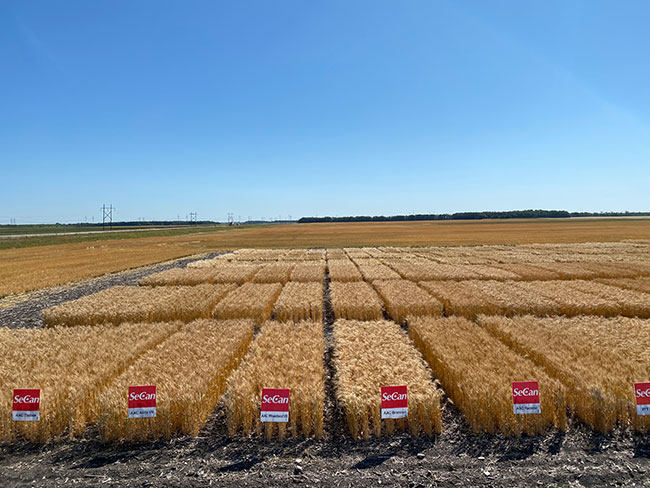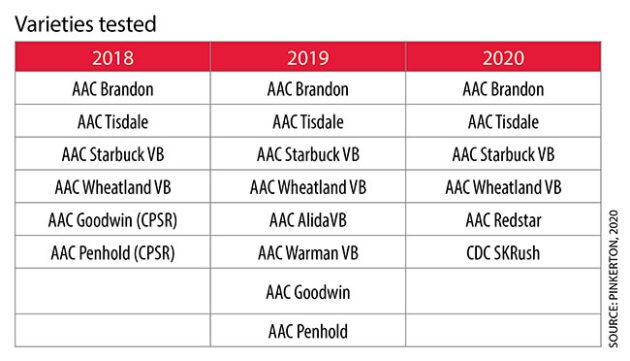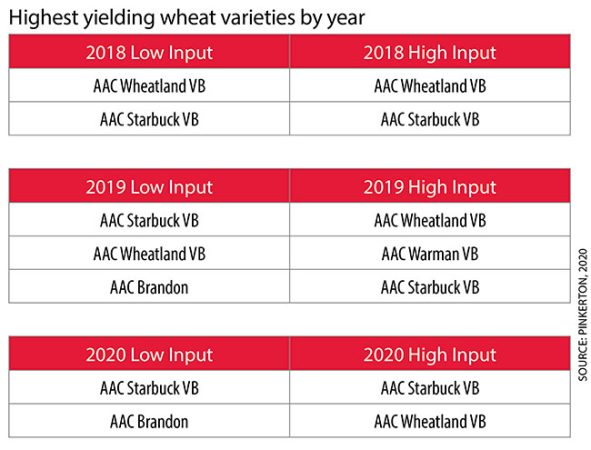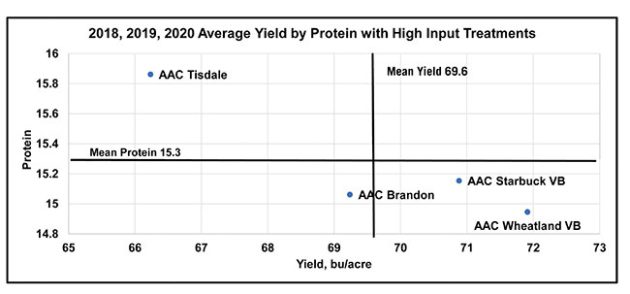
Features
Agronomy
Cereals
Matching wheat variety with management style
Research looks at variety performance based on input levels.
May 6, 2022 By Bruce Barker
 The best performing wheat variety under high input management also performed the best under low input management. Photo by Bradley Pinkerton.
The best performing wheat variety under high input management also performed the best under low input management. Photo by Bradley Pinkerton. Do some wheat varieties perform better with high or low agronomic input levels? That’s the question that Bradley Pinkerton, Manitoba marketing rep with SeCan, set out to answer in 2018.
“I go to a lot of tradeshows and talk to a lot of farmers throughout the year, and I’m always getting questions about which wheat varieties perform better under different management systems,” Pinkerton says. “Which variety would be best under high input management, and will the same variety be best under low management? Those are the kind of questions that I always get.”
To answer those questions, Pinkerton conducted research at five sites in Manitoba (Elm Creek, Fort Whyte, Warren, Grosse Isle, Minto and Carberry) and two sites in Saskatchewan (Redvers and Ridgedale) over three years from 2018 through 2020.
Two input levels were compared. The low input treatment targeted 60 bushels per acre with the fertility package, used no seed treatment, a low seeding rate of 19 seeds per square foot, and a leaf fungicide only if necessary.
The high input used a fertility target of 100 bushels per acre, used the best seed treatment available, a high seeding rate of 28 seeds per square foot, applied Manipulator plant growth regulator (PGR), and applications of a fungicide at the leaf stage to target leaf diseases and at the heading stage to target Fusarium head blight.
Varieties tested
 Pinkerton initially included two Canada Prairie Spring Red wheat varieties, AAC Goodwin and AAC Penhold, but dropped them in 2020 because the popularity of this wheat class was declining because of lower returns. The other varieties were in the Canada Western Red Spring (CWRS) wheat class. Not including the CPS varieties, AAC Tisdale had the highest yield gain in the high input treatment, as compared to the low input treatment in 2018 (more than nine bushels per acre) and 2019 (6.5 bu/ac). CDC SKRush had the highest yield gain in 2020 at around nine bu/ac.
Pinkerton initially included two Canada Prairie Spring Red wheat varieties, AAC Goodwin and AAC Penhold, but dropped them in 2020 because the popularity of this wheat class was declining because of lower returns. The other varieties were in the Canada Western Red Spring (CWRS) wheat class. Not including the CPS varieties, AAC Tisdale had the highest yield gain in the high input treatment, as compared to the low input treatment in 2018 (more than nine bushels per acre) and 2019 (6.5 bu/ac). CDC SKRush had the highest yield gain in 2020 at around nine bu/ac.
However, while AAC Tisdale responded the most to higher inputs, its yield was still lower than the other varieties. Most of the other varieties outyielded AAC Tisdale in both low and high input scenarios in all years. For example, AAC Wheatland VB yielded 79 bushels per acre in 2018 in the low input treatment and 86.5 bushels per acre in the high input treatment. This compared to AAC Tisdale at 67 bushels in the low input treatment and 76.3 bushels per acre in the high input treatment.
“AAC Tisdale usually showed the highest yield response to increased inputs, but usually had lower yield. So just because a variety responds to an input, doesn’t mean it will be the most profitable,” Pinkerton says.
Highest yielding wheat varieties by year
 The reverse was true for protein content. AAC Tisdale had the highest protein content response from low to high input levels, and the highest protein content in all three years. This wasn’t totally unexpected as the variety has one of the highest protein content ratings in the Seed Manitoba variety guide.
The reverse was true for protein content. AAC Tisdale had the highest protein content response from low to high input levels, and the highest protein content in all three years. This wasn’t totally unexpected as the variety has one of the highest protein content ratings in the Seed Manitoba variety guide.
Pinkerton plotted average yield and protein by wheat variety to look for trends. In the low input treatments, AAC Brandon, AAC Starbuck VB and AAC Wheatland VB all yielded higher than the average yield of 63.5 bushels per acre, but with slightly lower average protein content in the low input treatments where the average protein content was 14.6 per cent. In the high input treatment, AAC Starbuck VB and AAC Wheatland VB both had higher average yields, but still lower than the average protein content of 15.3 per cent. It should be noted, though, that the protein content of these varieties all came in higher than the minimum 13.5 per cent level required for protein premiums in both low and high input treatments.

Source: Pinkerton, 2020
A few challenges were encountered in the research. Not all management steps were taken at every location, partially due to logistics or timing. Two of the years were very dry, resulting in yields as low as 40 bushels per acre at some locations. The dry conditions also meant much higher protein than normal, low disease pressure and minimal lodging.
“Because of the dry conditions, we didn’t see any benefit to fungicide applications for leaf disease or Fusarium head blight, or a benefit to the PGRs,” Pinkerton says. “The economic return wasn’t there either. With an average yield increase of six bushels per acre, the high-input treatments easily cost an extra 80 dollars an acre. It just wouldn’t pay on a 40-bushel wheat crop.”
The key takeaway, though, is that the variety that yields the best in high input management will usually also be the highest yielding in low input management scenarios as well.